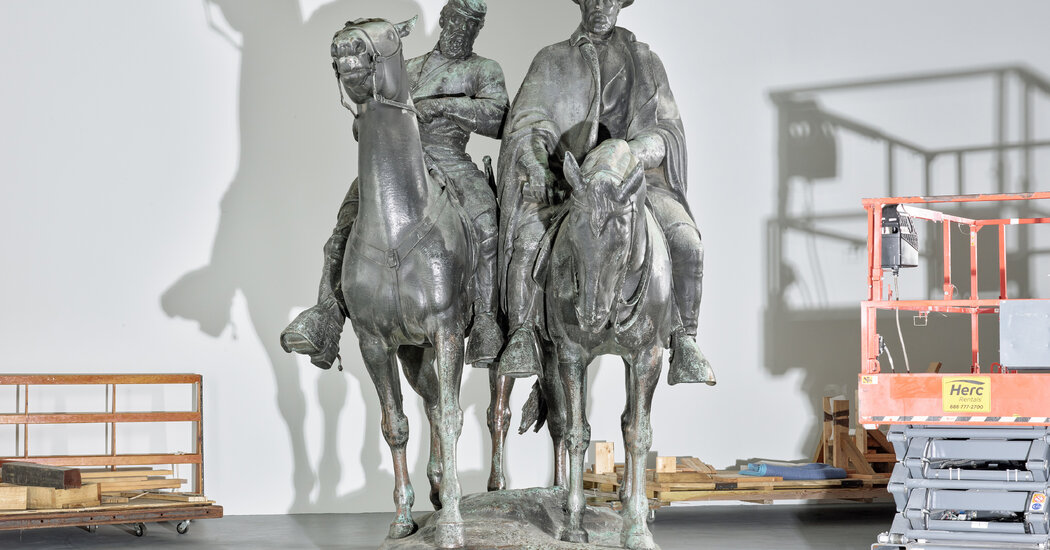In the fall of 2023, at a foundry outside Virginia, a team of welders in protective gear dropped pieces of a Robert E. Lee statue into a 2,250-degree furnace. An arm disappeared into the heat, then a leg. It took many multihour sessions to liquefy the monument of Lee astride his horse. When they were ready to burn Lee’s face, they cut it from the head with a torch and lowered it into the molten abyss. As it melted, his mouth seemed to widen into a scarlet scream.
This was about more than the transformation of an old artifact. It was an attempt to destroy myths about the Civil War and the righteousness of the Southern cause that had persisted for over a hundred years.
The Lee monument went up in the early 20th century, when a campaign of racial terror was rapidly spreading across America, enforcing a postwar social order that positioned white people on top. Jim Crow segregationist policies were being instituted, and the Ku Klux Klan was reviving, galvanized by “The Birth of a Nation,” the 1915 film by D.W. Griffith that portrayed African Americans as violent caricatures. This, rather than the war or its immediate aftermath, was the era when massive public monuments to the Confederacy were erected, specters of a past to rule the present.
In 1918, a stockbroker from Charlottesville, Va., named Paul Goodloe McIntire decided to support the efforts. He commissioned the Lee statue and donated it to the city. (McIntire is also responsible for several other Confederate monuments in the state.) He purchased a whole block and razed it to be a permanent home for the statue, acquiring land near a prominent Black neighborhood, as many of the funders behind these projects did.
Black residents began protesting the statue, and those protests continued on and off for nearly 100 years. But the stewards of the Lost Cause ideology — the discredited notion that arguments over states’ rights, rather than slavery, caused the Civil War and secession — were tenacious: The hand-typed 1996 application to the Department of the Interior to include the monument in the National Register of Historic Places described Lee as the “most eminent Confederate hero of all.”
In 2012, Kristin Layng Szakos, a member of the Charlottesville City Council, suggested that the city consider removing its Confederate monuments. “By the gasps around me, you’d have thought I’d asked if it was OK to torture puppies,” Szakos told The Daily Progress. Finally, in 2017, after the massacre of nine African Americans at the Emanuel African Methodist Episcopal Church in Charleston, S.C., the Charlottesville City Council voted to remove the statue. Not long after, neo-Nazis and white supremacists organized a Unite the Right rally and descended on the city, chanting, among other things: “You will not replace us.” The gathering turned violent when one of them drove a car into the crowd, murdering a counterprotester and injuring dozens of others.
What followed were years of protracted legal proceedings. In April 2021, the injunction preventing officials from removing statues was at last lifted. Lee was taken down and stored at a city-owned facility. The inevitable question arose: What now? The city solicited proposals, and a local, Black-led nonprofit called the Jefferson School African American Heritage Center suggested melting it down for an artist to create something new. The project was named Swords Into Plowshares, after a phrase from the Bible that portends a time of unconditional peace.
The school understood the power that the statue still held. “Recontextualization is not enough,” it wrote in its pitch. “Even taken from its pedestal … the social codes engendered by the Lee statue will allow it to remain an icon of violent white supremacy wherever it is placed.” The City Council voted to turn it over to the Jefferson School. Two tons of purified liquid bronze were poured into molds stamped with a bird in flight.
Across the country, a curator named Hamza Walker was closely observing the unrest over the decommissioning of dozens of Confederate statues. He had been riveted by the country’s sudden willingness to examine its racist past, a movement that took hold in 2016 and accelerated in 2020 after the murder of George Floyd. Protesters around the country — and then the world — toppled monuments of historical figures responsible for colonialism and slavery. “This is one of the most significant things to ever happen in my lifetime,” he told me in one of our interviews over the last two years. “Are we trying to rip the wiring out and go back to Square 1? That’s remarkable.”
As the director of the Brick, a nonprofit arts space in Los Angeles, Walker began to piece together the idea of an art show that would put these statues into conversation with works by contemporary artists. He eventually persuaded the artist Kara Walker (no relation), who has done provocative work with alternative monuments, to be a co-curator on the project. “These things have come down and nobody knows what to do with them,” Hamza Walker told me. “Do they still maintain their aura, or do they become artifacts?”
After securing the partnership of the Museum of Contemporary Art in Los Angeles, he traveled around the country visiting community centers, local museums and municipal lots where the monuments were being stored, and asked whether they could be used in a public art show. “We triggered a set of questions for municipalities who didn’t know who should handle the request or who had the final authority,” Walker said. “Which was its own fascination.”
In some cases, it was easy to acquire the monuments. The descendants of Josephus Daniels, a prominent North Carolina publisher who bought and merged several newspapers and used his platform to promote segregation and incite violence, were willing to lend his eight-foot likeness to the show. (It was taken down in 2020 from its perch in Raleigh, N.C.) The Jefferson School, too, was keen to lend its coppery bricks. But Walker was unsuccessful in obtaining one statue that was under federal stewardship. When it came to taking possession of a Stonewall Jackson monument, Walker went to Charlottesville to ensure it was spirited across state lines to keep it from further legal threats.
The show was originally scheduled to debut in 2023, but it was delayed a few times by institutional logistics and security. Safety measures to protect employees had to be put in place, including hiring extra security guards. The organizers were right to be worried: In 2017, one of the contractors hired in New Orleans to remove four Confederate monuments had his Maserati firebombed. (Walker plans to include a photograph of the incinerated vehicle in the show’s catalog.) And shipping the enormous statues across the country has been costly; the footprint of another Lee monument, in Richmond, Va., alone was half the size of a football field.
Eight years after Walker first thought of the idea, the show, which contains 11 decommissioned monuments and work by 19 contemporary artists, opened at the Geffen Contemporary at MOCA on Oct. 23, at a moment that feels like a stark shift from the one the show was conceived in, with Donald Trump’s administration systematically reversing civil rights and enforcing a sanitized view of American history. Walker now thinks about the show as a survey of all that has happened since the Mother Emanuel killings. “It’s a way of asking and reflecting on the last decade — not about now,” Walker told me. “Is the past even the past?”
In mid-September, I arrived at the Geffen Contemporary in downtown Los Angeles to visit the show’s installation in progress. I was immediately stunned by the enormousness of the space, a 40,000-square-foot warehouse with lofty ceilings. Once used to house police vehicles, it is one of the few places in the city that can hold the monuments, many of which weigh hundreds of pounds. Yet when I entered the building, it felt cramped. Tight.
Part of it was psychological. When I visited, only a handful of the monuments were arranged in the cavernous rooms. Yet each of their energetic footprints felt colossal. They drew the air out of the space, turning it into a haunted mausoleum. Initially, I didn’t want to be around them. I grew up in Virginia, and the statues and the inhumane ideas they celebrated shadowed my childhood. But seeing these figures here, now, sitting in their temporary new home, as if they were naughty children in a timeout, was surprisingly satisfying. I stood near the drawn-faced likeness of Roger B. Taney, which was tucked into a corner next to dollies and equipment awaiting its placement. Taney was the Supreme Court chief justice who delivered the majority opinion in the 1857 Dred Scott case ruling, which decreed that African Americans were not and could never be U.S. citizens. There was some relief — threaded through with triumph — at seeing at least one of the many monuments to him that are installed around the United States turned into a shameful dummy.
As Walker and his co-curator Bennett Simpson showed me around, they seemed to be vibrating with fatigue and excitement. They pointed out the first work that will greet visitors as they enter the space: nine pieces of granite from the base of the Lee monument that was removed from Richmond in 2021. Each piece bore a poignant graffiti tag from the days of Black Lives Matter protests: “# Days w/o An Extrajudicial Execution of a U.S. Citizen: 0.” “Protect Trans Black Women.” One simply had a yellow smiley face painted on it. As we rounded a corner, Simpson asked whether I remembered the Robert E. Lee monument that had ignited so much chaos in Charlottesville a decade ago. He made a grand, flourishing gesture to a wall stacked with gold-colored ingots. “Well, this is the Robert E. Lee monument now.”
The bars shimmered under studio lights, oblivious to their origins. Nearby stood a cobalt blue hazardous waste can, on top of which sat a jar of tacky black shards — a small portion of the impurities that came out of the bronze during the smelting process. The implication of the installation was that the dirty residue of Lee’s reign had been cleared from the metal, too — and perhaps from our collective psyche.
I stared at the display, trying to reconcile the pile of bricks in front of me with the monument, which I last saw in person in 2017 while visiting my alma mater, the University of Virginia. To mollify the protesters during the years when the city was still wrangling over the removal of the statue, Lee and his horse were hidden under giant black tarps, as if their malignant energy could be contained. Five years later, that energy seems to have escaped, so much so that scholars wonder whether we are in a Neo-Redemption period, mirroring the time at the turn of the century when advances in political and civil rights established in Reconstruction were violently and systematically stripped away.
History is being rewritten in frighteningly ideological ways. In addition to attacking and defunding universities, Trump signed an executive order — titled “Restoring Truth and Sanity to American History” — that called for a national review of historic sites to ensure that no images, language or other content “inappropriately disparage Americans past or living.” As a result, the government ordered the removal of many signs and exhibits related to slavery and Native Americans. In August, he called the Smithsonian Institution “out of control” for focusing on “how bad Slavery was.”
Looking around, my gaze landed on a statue of Jefferson Davis — the first and last president of the Confederacy — that once stood in Richmond, until it was drenched in pink paint and toppled, which caused the statue’s head to be nearly separated from its body. Davis now lies supine in the museum, his outstretched hand extending skyward as if for help that will never come. I thought of something the historian Jason Stanley wrote in his book “Erasing History,” that “history in a democracy is not static, not mythic, but dynamic and critical.” The exhibition is a pointed reminder of that dynamism, the sense that our history is constantly being made and remade, despite the best efforts of those trying to freeze it in place.
Hamza Walker was born in 1966, so generationally, as he put it, he is a post-civil-rights-era child, his social consciousness informed by a milieu of interracial friend groups, Lynyrd Skynyrd on the radio and watching “Roots” on television. His sense of humor is acerbic, borderline goofy. (“I’m prone to self-amusement,” he told me once. “Black people and our survival strategies!”) He spent a large portion of his adolescence as a “young Black punk” in Baltimore, a city rife with tributes to the Confederacy. He remembers one day passing through a park named for Robert E. Lee and thinking to himself: Wait, I don’t understand. They lost the war.
He now sees it as his personal mission to educate the public about how the Lost Cause ideology was a propaganda campaign taught in schools and reinforced by racist legislators and their deep-pocketed co-conspirators — a campaign that continues today, repackaged in new, insidious forms. “Take Charlie Kirk,” he told me. “He openly espoused the Great Replacement beliefs that are totally contrary to what I want to believe this country stands for — and he has a bronze statue planned. That’s the same thing as the Lost Cause.”
In June, I accompanied Walker on a studio visit to Bethany Collins, an artist who was making a sculpture from the base of the Stonewall Jackson monument that had stood near the Lee in Charlottesville, transforming the pink granite into flower petals.
Collins, soft-spoken and warm, welcomed us into her studio in a repurposed industrial building near the neighborhood of Oak Park. She explained that she has long been interested in floriography, or the Victorian Era practice of encoding meaning in flowers. An iris could represent burning love, while milkweed might be a plea to be released from a lover’s grasp. For the granite, she chose the Carolina rose, which according to some of her flower dictionaries means “love is dangerous.” “It’s a language of violence and beauty, which is very Southern,” she told me.
In the basement of the building, Collins showed us some early failed experiments with the material. They looked like remnants of broken flatware, flower-ish but only if someone told you that’s what they were. Initially, the granite refused to be transformed by a chisel and hammer. “It’s so hard, but you’d be surprised at how fragile it actually is,” she told me. “I don’t believe in curses often, but this material had something on it,” she told me. “It did not want to be changed.”
But it was eventually as susceptible as anything else to pressure, patience and some brute force. After using a diamond-tipped saw to cut the granite into thin slabs, she dropped some of them onto glass marbles, a technique that a third-generation stone carver shared with her. “It shattered the stone in uncontrollable ways,” she told me. Most of the marbles, from the 19th century, remained unscathed. Collins also sent some pieces to another stone carver in Vermont who was able to fashion beautiful petals that fit into the palm of your hand like a precious stone.
We rode the elevator upstairs, where she showed us the fruits of that labor. One stone flower was delicately teetering on the remains of the monument’s base, as if it were recently shed by a tree. “It feels intentionally hushed versus being quiet,” she said to both of us. They discussed the effect of increasing or decreasing the density of the petals. “Sometimes sparse is clarity,” Walker replied as she added more to the ground. She made 100 intact petals in total, to echo the 100 years it took for the statue to come down. I marveled at seeing something so masculine and violent be reformed with beauty and gentleness. But the piece produced a tinge of fear in me, too — a fear of hoping too hard that such a metamorphosis was possible, or could be permanent. “This is what good art does,” Walker said. “It gives something another form. It makes it poetry.”
The Carolina rose is an intricate pink petal. I held one in my hand, feeling the tension between the hefty weight and the delicate scalloped edges, which remind you that these are meant to mimic something still living. These flowers are a powerful tribute to refusal, an acknowledgment that Jackson’s metaphorical remains need not be absorbed into the land. They do not have to be fertilizer, feeding something to grow anew in their place. Over the last five years, as Walker has worked on the show, activists and artists have reached out to him to voice their concerns about how the monuments will be shown. Each time, he sent them the same reply: “There will be no further veneration, at all.”
Acquiring the Lee sculpture took some harried finagling. Walker initially wrote up a proposal to acquire the statue and repurpose it for the show and submitted it to Charlottesville’s City Council, which voted to give it to Walker. The city was eager to be rid of it, and he quickly had it moved to a private warehouse in New Jersey. Walker worried that Glenn Youngkin, the incoming Republican governor, might stymie his efforts. And indeed, in 2022, a spokeswoman for Youngkin’s office said, “We must resist the movement to cleanse our history.”
A portion of the base went to Collins, but for the body, Walker immediately thought of Kara Walker, whom he has known since the 1990s. Her work depicts antebellum horrors as grotesquely compelling, indicting both the white Southern perpetrators she portrays and the visitors who come to view them as joint participants in a spectacle of Black subjugation.
Kara Walker had already been working through her own ideas about the genre of monuments, starting in 2014 with a 36-foot-tall sphinx of a mammy-like figure wearing a kerchief with exposed breasts and vulva. You can think about the installation, “A Subtlety, or the Marvelous Sugar Baby,” as having multiple layers. There’s the physical part of the work, and there’s the way visitors choose to interact with it. Many, unprompted, abused the sphinx, posting photographs online where they mimed grabbing at her genitals. Monuments, at their core, are about the consolidation of ideas, however noxious, into material objects. Much of their power is subtle. Many of us pass a sculpture daily without knowing who or what it represents, or its impact on our psyche. Through her work, Walker reveals how our attitudes are shaped by the narratives impressed upon us — in this case, that it is socially acceptable, even expected, to mock a figure representing Black women.
She later worked on a commission for the Tate Modern where she erected a four-tier fountain — meant to represent her own version of the Queen Victoria Memorial that lives in front of Buckingham Palace. That work, “Fons Americanus” (“Fountain of America”), depicts the gory origins of the modern world’s wealth — colonial figures and tormented Africans — as supported by the British Empire. Into this chaos she incorporates a young boy submerged in a pool of water, his head barely lifted above the surface, his round, terror-flecked eyes perpetually streaming.
When Hamza Walker first approached her, she said she was “a tentative maybe.” She had grown up surrounded by Jackson’s legacy as a teenager in Atlanta, where her father, an artist, moved the family after taking a new job as the head of the art department at Georgia State University. Coming from California, where she’d lived her whole life, the South was a culture shock. Her peers spent their free time at Stone Mountain Park, where Davis, Lee and Jackson are carved into three acres of the quartz and granite dome.
Stone Mountain was originally owned by two brothers, one of whom was a Ku Klux Klan member, and it became a core site of the group’s resurgence in the 1950s. It hosted huge initiations and cross burnings there. The place became such a symbol of white supremacy that the Rev. Dr. Martin Luther King Jr. mentioned it by name in his “I Have a Dream” speech. Even today, the surrounding park is a tourist attraction. A couple of times, Walker went, too, with all of her “freaky high school friends.” She found it to be a disturbing place. On summer weekends, there were laser shows that included an animation set to Ray Charles singing “Georgia on My Mind.” Locals still denied the site was an altar to the slavery era, and Walker was deeply affected by this refusal of reality. “Even then, teenage me wondered what it meant to have all of this stuff under the surface,” she told me when I interviewed her this summer in Rhode Island, where she lives part time and has a studio.
Perhaps recalling her time in Georgia, she was persuaded by Hamza Walker to visit the Jackson at the New Jersey warehouse. “People wanted to make them go away, make the bad feelings leave us now,” she said of the Confederate sculptures. Standing before Jackson, she became “curious about what it means to bring them back out.”
The Jackson monument portrayed the Confederate military general astride Little Sorrel, his horse, and Kara Walker became fixated on it. “This horse took no sides in the war,” she said, with a sardonic chuckle. “He was simply there.” Long after Jackson died, his horse was trotted out at county fairs and Confederate reunions, where fanatics took bits of his mane and tail as trophies. “He was getting picked clean, because he’s a ‘hero’s horse.’” When he died, he was skinned and taxidermied and installed at the Virginia Military Institute, where his stuffed form still resides today. (Its statue of Jackson, meanwhile, was removed from the campus in 2020.) “And that was my inspiration — this horse being butchered as the sustenance of a failure. So I transformed the horse and rider into an emblem of despair. And what does it look like if you just live that instead of try to make it victorious?”
She named her piece “Unmanned Drone.” To construct it, she created a 3-D scan of the sculpture and rearranged the parts digitally before taking a plasma cutter to the monument itself. She sliced it up with the help of a foundry, using anatomy guides and butchering instructions. The resulting piece is a demented Rorschach test, a mangled mess of bronze arms and hoofs, tail and jaws. Walker didn’t try to give Jackson new context; she simply removed it altogether, turning him into a work that looks like several monstrosities at once, forcing him to drown in a quicksand of his own barbarity.
“Hamza kept trying to reconstruct it — ‘Is that the horse’s ass?’” she recalled with delight, describing the moment when her co-curator first saw the work. She mimed him staring at the sculpture and pointing out its Frankensteined parts.
“Stop trying to bring the Confederacy back,” she retorted, with a throaty laugh. “None of those parts are anything anymore.”
Before I left Los Angeles, I visited the Geffen Contemporary one last time. In one room, the farthest in the back, stands an orange 1969 Dodge Charger with a Confederate flag and “General Lee” emblazoned on its roof — a facsimile created by the artist Hank Willis Thomas of the iconic car from the 1980s comedy series “The Dukes of Hazzard.” It’s the kind of toxic artifact that pop culture is deft at disguising as harmless. The crumpled hood collides with the floor at a 90-degree angle, as though it fell from the sky. The angle allows you to walk around and examine the innards of the vehicle’s machinery. Despite its alarming iconography, you can see that it is simply a car, and a broken one.
Another statue, called the Confederate Women’s Monument, features a figure standing tall, gazing into the horizon, her face set with a serene determination, her cloak flowing with the artificial drift of a D.C. superhero’s cape. Another woman kneels at her feet, cradling a soldier who is either dead or on the verge of death. The tilt of the man’s face and position of his body draped over her lap mirror Michelangelo’s Pietà, which depicts the Virgin Mary holding Jesus after his crucifixion. Across the hall are Jon Henry’s photographs of Black women holding the limp bodies of their sons, reflecting the mothers’ fears of police brutality. The space between the monument and the photographs became charged with the force of an indictment.
The show also uses contemporary work to show the alternative ways that history can be acknowledged, even rewritten. Stan Douglas, a Canadian artist, took on Griffith’s “Birth of a Nation,” which became a cinematic altar to the white nationalism. He reshot the gut-wrenching sequence where Gus, an African American man (played by a white actor in blackface) aggressively pursues a white woman until she jumps off a cliff to her death; he is subsequently lynched. The video installation features several vantages on this encounter, including newly shot scenes of an African American character, played by a Black actor. It is his narrative that feels the most potent: The new character moves throughout the film in peace, on his own journey, untouched by the mob and its hatred.
The longer I stayed, the more I thought about what imbued the sculptures with their power. So much of it comes from their ability to disappear into the landscape and obfuscate the truth of their meaning. There are still over 100 Lee monuments around the country, not just statues but also road names, universities and high schools. Hamza Walker reminded me, again and again, that while 200 or so monuments came down, there are upward of 600 still in place. The show allows us to see these relics for what they are. There is a clarity and definitiveness available in those rooms — and yet I couldn’t help thinking about the long history of unwillingness to agree on a shared version of reality.
I thought back to something Collins told me in Chicago, that she was first inspired to turn the Jackson base into petals after reading about the emergence of new traditions of memorialization during the war and in its aftermath. One, called Decoration Day, was established by newly freed Black Americans, and it became a yearly tradition of carrying flowers and wreaths to the graves of the Union fallen. Today, we know it as Memorial Day, with its marching bands and jets streaming colored smoke.
In her research, Collins found herself riveted by a group of South Carolina women who processed during that very first Decoration Day in 1865. They named themselves the Patriotic Association, signifying a bold allegiance to a country that fought to continue torturing them. But perhaps those women also felt an opening, the possibility of alchemizing their pain into a sense of belonging and ownership. Trying to figure out if they could claim the present — and future — for themselves. Love is only dangerous if the object of your affection will never love you back.
The post How to Make Art Out of Confederate Monuments appeared first on New York Times.




